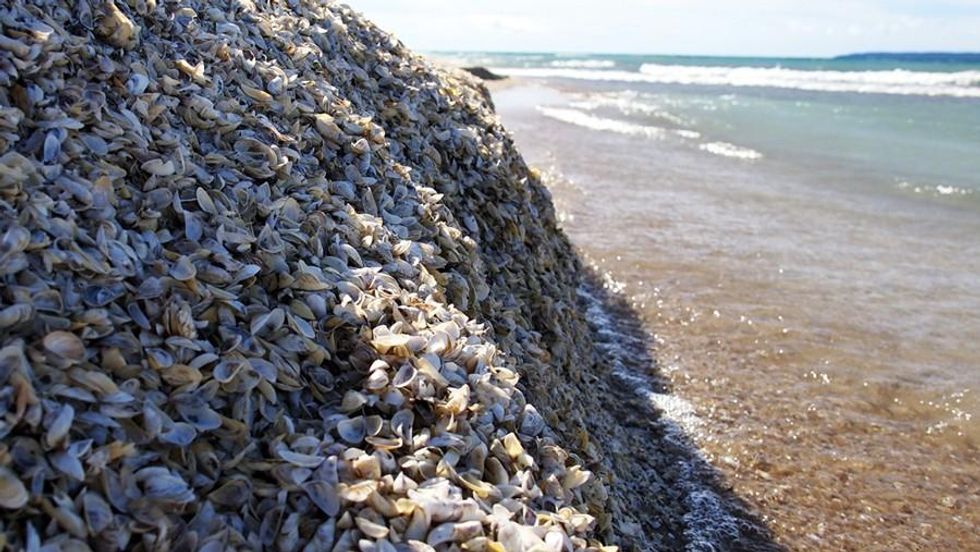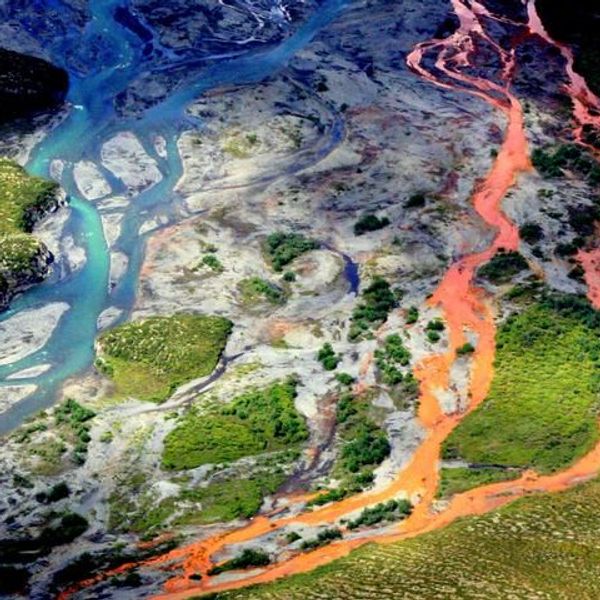Not Just Oceans and Atmosphere, Rapid Warming Killing World's Lakes
Rapidly warming lakes are warning sign of possible water insecurity, 'substantial economic consequences,' and, in some cases, 'complete ecosystem loss,' researchers found.
The world's lakes are warming at a faster rate than oceans and atmosphere, a trend that may already have triggered major changes in aquatic ecosystems, according to a new report published in Geophysical Research Letters on Wednesday.
Globally, lakes have been heating up an average of 0.34degC (.61degF) per decade between 1985 and 2009, researchers found. In northern climates, the deepest ice-covered lakes are warming at twice the rate of the atmosphere.
"The widespread warming reported here suggests that large changes in Earth's freshwater resources and their processes are not only imminent but already under way," the study concludes.
When lakes warm, their productivity decreases and they become more likely to form toxic algae or become vulnerable to damage by invasive species. That, in turn, threatens delicate ecosystems within the lake, including fish and other wildlife, which can lead to water insecurity, "substantial economic consequences," and, in some cases, "complete ecosystem loss," the study states.
The global average lake surface warming rate during summer seasons implies a 20 percent increase in algal blooms and a five percent increase in toxic algal blooms over the next century, researchers found. That could ramp up dangerous methane gas emissions by 4 percent over the next decade.
"Lakes hold a large majority of Earth's liquid freshwater, support enormous biodiversity, and provide key provisioning and cultural ecosystem services to people around the world. Climate change is among the greatest threats to lakes," the study states. "The pervasive and rapid warming observed here signals the urgent need to incorporate climate impacts into vulnerability assessments and adaptation efforts for lakes."
The researchers focused their study on lakes because their temperatures typically remain stable over time--unlike air, which fluctuates in temperature daily--making them particularly useful in measuring climate change.
"Obviously, Lake Superior is going to stay cold for a very long time," University of Minnesota Duluth Professor Jay Austin, one of the study's co-authors, told the Star Tribune. "But these lakes provide a sort of 'climate antenna' that allows us to look at these global trends."
"Relatively small changes can lead to large changes in systems that define our region," Austin continued. "Duluth would be a fundamentally different place if Lake Superior never formed ice."
The study is the largest of its kind, analyzing temperatures of 235 lakes across six continents that represent more than half of the world's fresh water supply.
"Society depends on surface water for the vast majority of human uses," said co-author Stephanie Hampton, director of Washington State University's Center for Environmental Research, Education and Outreach. "Not just for drinking water, but manufacturing, for energy production, for irrigation of our crops. Protein from freshwater fish is especially important in the developing world."

An Urgent Message From Our Co-Founder
Dear Common Dreams reader, The U.S. is on a fast track to authoritarianism like nothing I've ever seen. Meanwhile, corporate news outlets are utterly capitulating to Trump, twisting their coverage to avoid drawing his ire while lining up to stuff cash in his pockets. That's why I believe that Common Dreams is doing the best and most consequential reporting that we've ever done. Our small but mighty team is a progressive reporting powerhouse, covering the news every day that the corporate media never will. Our mission has always been simple: To inform. To inspire. And to ignite change for the common good. Now here's the key piece that I want all our readers to understand: None of this would be possible without your financial support. That's not just some fundraising cliche. It's the absolute and literal truth. We don't accept corporate advertising and never will. We don't have a paywall because we don't think people should be blocked from critical news based on their ability to pay. Everything we do is funded by the donations of readers like you. Will you donate now to help power the nonprofit, independent reporting of Common Dreams? Thank you for being a vital member of our community. Together, we can keep independent journalism alive when it’s needed most. - Craig Brown, Co-founder |
The world's lakes are warming at a faster rate than oceans and atmosphere, a trend that may already have triggered major changes in aquatic ecosystems, according to a new report published in Geophysical Research Letters on Wednesday.
Globally, lakes have been heating up an average of 0.34degC (.61degF) per decade between 1985 and 2009, researchers found. In northern climates, the deepest ice-covered lakes are warming at twice the rate of the atmosphere.
"The widespread warming reported here suggests that large changes in Earth's freshwater resources and their processes are not only imminent but already under way," the study concludes.
When lakes warm, their productivity decreases and they become more likely to form toxic algae or become vulnerable to damage by invasive species. That, in turn, threatens delicate ecosystems within the lake, including fish and other wildlife, which can lead to water insecurity, "substantial economic consequences," and, in some cases, "complete ecosystem loss," the study states.
The global average lake surface warming rate during summer seasons implies a 20 percent increase in algal blooms and a five percent increase in toxic algal blooms over the next century, researchers found. That could ramp up dangerous methane gas emissions by 4 percent over the next decade.
"Lakes hold a large majority of Earth's liquid freshwater, support enormous biodiversity, and provide key provisioning and cultural ecosystem services to people around the world. Climate change is among the greatest threats to lakes," the study states. "The pervasive and rapid warming observed here signals the urgent need to incorporate climate impacts into vulnerability assessments and adaptation efforts for lakes."
The researchers focused their study on lakes because their temperatures typically remain stable over time--unlike air, which fluctuates in temperature daily--making them particularly useful in measuring climate change.
"Obviously, Lake Superior is going to stay cold for a very long time," University of Minnesota Duluth Professor Jay Austin, one of the study's co-authors, told the Star Tribune. "But these lakes provide a sort of 'climate antenna' that allows us to look at these global trends."
"Relatively small changes can lead to large changes in systems that define our region," Austin continued. "Duluth would be a fundamentally different place if Lake Superior never formed ice."
The study is the largest of its kind, analyzing temperatures of 235 lakes across six continents that represent more than half of the world's fresh water supply.
"Society depends on surface water for the vast majority of human uses," said co-author Stephanie Hampton, director of Washington State University's Center for Environmental Research, Education and Outreach. "Not just for drinking water, but manufacturing, for energy production, for irrigation of our crops. Protein from freshwater fish is especially important in the developing world."

The world's lakes are warming at a faster rate than oceans and atmosphere, a trend that may already have triggered major changes in aquatic ecosystems, according to a new report published in Geophysical Research Letters on Wednesday.
Globally, lakes have been heating up an average of 0.34degC (.61degF) per decade between 1985 and 2009, researchers found. In northern climates, the deepest ice-covered lakes are warming at twice the rate of the atmosphere.
"The widespread warming reported here suggests that large changes in Earth's freshwater resources and their processes are not only imminent but already under way," the study concludes.
When lakes warm, their productivity decreases and they become more likely to form toxic algae or become vulnerable to damage by invasive species. That, in turn, threatens delicate ecosystems within the lake, including fish and other wildlife, which can lead to water insecurity, "substantial economic consequences," and, in some cases, "complete ecosystem loss," the study states.
The global average lake surface warming rate during summer seasons implies a 20 percent increase in algal blooms and a five percent increase in toxic algal blooms over the next century, researchers found. That could ramp up dangerous methane gas emissions by 4 percent over the next decade.
"Lakes hold a large majority of Earth's liquid freshwater, support enormous biodiversity, and provide key provisioning and cultural ecosystem services to people around the world. Climate change is among the greatest threats to lakes," the study states. "The pervasive and rapid warming observed here signals the urgent need to incorporate climate impacts into vulnerability assessments and adaptation efforts for lakes."
The researchers focused their study on lakes because their temperatures typically remain stable over time--unlike air, which fluctuates in temperature daily--making them particularly useful in measuring climate change.
"Obviously, Lake Superior is going to stay cold for a very long time," University of Minnesota Duluth Professor Jay Austin, one of the study's co-authors, told the Star Tribune. "But these lakes provide a sort of 'climate antenna' that allows us to look at these global trends."
"Relatively small changes can lead to large changes in systems that define our region," Austin continued. "Duluth would be a fundamentally different place if Lake Superior never formed ice."
The study is the largest of its kind, analyzing temperatures of 235 lakes across six continents that represent more than half of the world's fresh water supply.
"Society depends on surface water for the vast majority of human uses," said co-author Stephanie Hampton, director of Washington State University's Center for Environmental Research, Education and Outreach. "Not just for drinking water, but manufacturing, for energy production, for irrigation of our crops. Protein from freshwater fish is especially important in the developing world."


